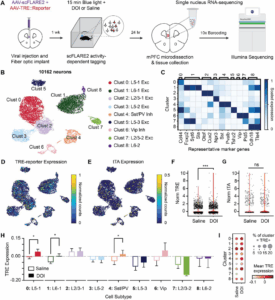
Image copyright: Science
Isolation of psychedelic-responsive neurons underlying anxiolytic behavioral states
Published in Science.
Authors
J Muir, S Lin, I K Aarrestad, H R Daniels, J Ma 1,2, L Tian, D E Olson, C K Kim
Paper presented by Dr. Tarun Madangopal and selected by the NIDA TDI Paper of the Month Committee
Publication Brief Description
Psychedelics, a class of drugs known to act on serotonergic 5-hydroxytryptamine type 2A receptors (5-HT2ARs), hold promise as alternative treatments for neuropsychiatric disorders but are limited by hallucinogenic side effects. Understanding the neural mechanisms by which psychedelics exert these opposing effects could enable development of more targeted therapies. To this end, Muir et al. used a 5-HT2AR–based fluorescent biosensor, psychLight2, along with in vivo calcium imaging to characterize the brain-wide activity and behavioral effects of the psychedelic 2,5-dimethoxy-4-iodoamphetamine (DOI). They then employed scFLARE2, a light- and calcium-dependent activity labeling system, to tag neurons activated by DOI in the medial prefrontal cortex, and applied single-nucleus RNA sequencing to reveal that DOI induces network-level activation of both excitatory and inhibitory neurons—extending beyond those directly modulated via 5-HT2ARs. Finally, they used optogenetics to selectively reactivate this DOI-activated mPFC population and demonstrated that it is sufficient to reproduce DOI’s anxiolytic-like effects without inducing hallucinogenic-like behaviors. Overall, this study provides a framework for dissecting psychedelic-responsive circuits and developing therapeutics that separate clinical benefit from adverse effects.
Isolation of psychedelic-responsive neurons underlying anxiolytic behavioral states Journal Article
In: Science, vol. 386, no. 6723, pp. 802–810, 2024, ISSN: 1095-9203.
